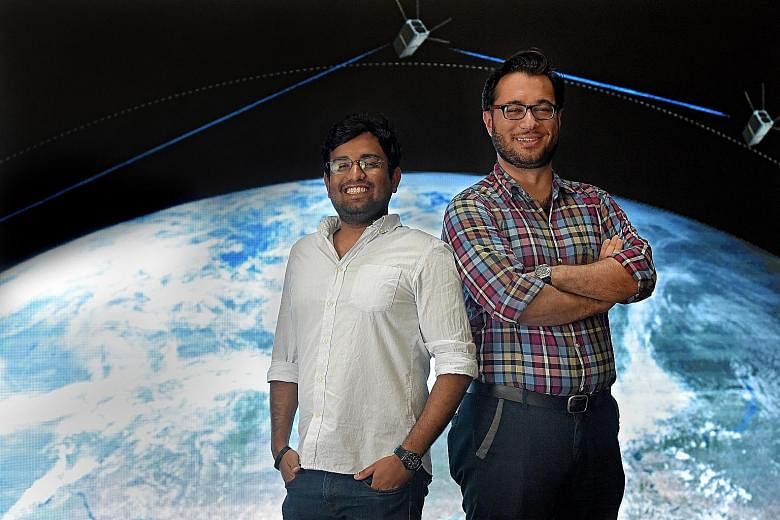Q Tell us about the idea behind Transcelestial.
Mr Jha Ours is a start-up company which is working on creating a prototype that will use laser technology to transmit data at greater distances but with a faster speed and at a lower cost.
There has been tremendous progress in land-based data communication networks, with technology moving from copper wires to fibre optics where light is used as a medium of transmission.
We are bringing the same idea to wireless technology - using light waves instead of the current radio frequency waves for data communication.
Dr Danesh We are looking to use satellites to do this. Data will be transferred using razor-thin laser beams from satellites in space, pointed accurately at telescope-like ground stations. Despite the distance, the transmissions have to be precise and fast and will use less energy than is required to power a light bulb.
Once this ecosystem is in place, our bigger vision is to bring about inter-operability with other networks and satellites, and possibly have a standardised system in satellite technology.
Q How did you two meet, and how did this idea take shape?
Mr Jha It was a meeting of minds for Danesh and me at Entrepreneur First (EF), which provides a platform for deep technical innovations. We are part of a batch of 50, who applied to and were selected by the Singapore chapter of EF.
I have a bachelor's degree in electrical and electronics engineering from Nanyang Technological University, while Danesh holds a doctorate from the National University of Singapore.
At EF, participants look for other creative minds from diverse fields to team up with, and ideate on an innovative new product. It's like dating someone for a creative outcome, and if the minds don't meet, breaking up and looking for another partner to collaborate with. This process is repeated until you find the right one. In our case, Danesh and I hit it off almost instantly.
Dr Danesh Both of us are space enthusiasts, so we were looking at doing something related to satellites and space technology. Rohit has worked with lasers before, and I have a doctorate in nanophotonics - which deals with light on a nano scale. We zeroed in on this idea that will make use of our passion and put it to practical use.
Once we had decided on the product, we researched the market to gauge demand, and realised that many satellite companies, data companies, telecoms, etc, are in need of the technology we are offering. They gave a positive response to our idea, and Transcelestial was born.
Q What is the prototype you are working on?
Mr Jha There are two components to this prototype. One is the transmitter - a module which will be plugged on to cube satellites or CubeSats orbiting the earth.
The second is the ground station to receive transmissions from these modules on CubeSats. They will resemble telescopes and will catch the beams transmitted from space and collect the data.
This data transfer works both ways, that is, from ground to satellite as well. Right now we are building the hardware and writing the software for these devices.
Dr Danesh There will be an eco-system of such modules orbiting around the earth. They will talk to one another and communicate with the ground stations as well.
Q How is your technology different from the existing one?
Mr Jha Currently, Radio Frequency is used to transmit data wirelessly, but it has a number of drawbacks. The RF waves have larger wavelengths which need cumbersome hardware to transmit and receive these signals - think huge underground cables or big dish antennae. This is expensive and difficult to replicate in remote places.
The spectrum is also limited in its capacity to carry data, experiences a lot of interference and is saturated. Our laser beams, on the other hand, have much more bandwidth, hence they can carry more data at a fraction of the cost.
A simple comparison would be with dial-up modems of the past, which were slow and gave rise to bad websites. The broadband and fibre optics of today have enabled rich and intensive applications and faster connectivity.
Dr Danesh The same things are happening with satellite communications. The promise of having cost-effective Internet anywhere has been long touted, but it can't be done because of the outdated technology.
Satellites collect a lot of data, because of better sensors like cameras and videos, etc, but parts of it are discarded because the capacity of transmission technology has not evolved on a par. Which means sending data from satellites is very expensive, which is one of the reasons people do not take up satellite communications or set up applications. With our technology, we will be able to build devices that can give thousand times more information at the same price.
Q What are the practical applications of this technology?
Dr Danesh One of the most practical applications can be in the aviation sector.
Imagine an aircraft flying over an ocean. It has no high-speed connection with ground control to transfer large amounts of flight data, and has to carry black boxes. In the event of an accident, experts have to wait for the black box to be found to analyse what went wrong. But if the aircraft can send data real-time to ground control, much time and cost will be saved, not to mention corrections to equipment made quickly.
But that is not happening now because sending data through geosatellites can take hours and cost a lot of money, and it is not feasible for commercial flights which operate on low margins to spend that kind of money.
Once we have our constellation of CubeSats carrying our modules in space, such communication will become easier. Plus, safety will be enhanced as ground stations will know exactly where the aircraft are and will be able to predict if something is amiss.
Q What is the next step for Transcelestial now?
Mr Jha We have come to the end of our six-month incubation period with EF this month. Their pre-seed funding of $55,000 has enabled us to sail through the conceptualising and initial stages.
Now our two-year research and development phase starts. In phase one, we will test our prototype on the ground at a distance of 1.5km, while phase two will include putting our modules on drones and lifting them 10km to 15km into the air to test the signals to and from the module and the telescope. We start building our tracking and pointing technology then.
Phase three will involve putting the modules on weather balloons and taking them to the edge of space. We will test our algorithm to counteract clouds, and start building ground stations. The last stage will be to collaborate with partners in the United Kingdom and Singapore space and technology sector, to get two CubeSats equipped with our modules in space by late 2018. We presented our business plan to around 200 investors yesterday and the response was encouraging.
Q What does the future hold for Transcelestial?
Mr Jha If we demonstrate our capability and raise enough funds, we hope to get our product in the market by next year. Traditional satellite manufacturers, telecom companies and financial services are among potential customers.
Dr Danesh We then want to launch 100 or more modules on CubeSats, have a constellation of satellites in space which will blanket the planet orbiting the Earth, and start operations.


